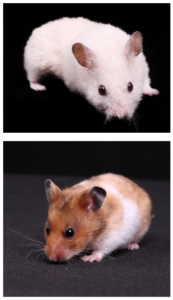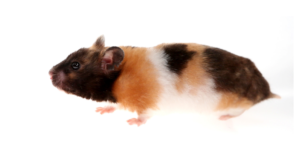This small pet can nonetheless occupy a big place in your heart.
If you’ve been to a pet store, chances are high that you’ve seen a Syrian hamster, as they are common pocket pets found in pet stores. Swirly.bitz is a hamster breeder famous in the trade in the Philippines because she breeds for the quality of the hamsters. She has been breeding Syrian hamsters for more than a decade, and sat down with Animal Scene to share her opinions and experiences regarding the keeping of the Syrian hamster.
A Long History with Humans

Syrian hamsters have been kept in captivity for centuries, and are the oldest breed of hamster being kept in captivity. Selective breeding has resulted in many different mutations being available. At first, only the agouti colors or the wild type were available, until other colors begin to mutate or change. Selective breeding continues to this day to maintain the quality of the hamsters and create new mutations. If you come across a dark gray Syrian hamster, expect it to be more expensive because Swirly.bitz explains that this color is quite rare.
There are hundreds of Syrian hamster colors and patterns, making it the hamster breed with the most number of mutations available today. It has a good temperament and tolerates handling well. There are two main types of Syrian hamsters: the golden and the teddy bear. The former are short-haired while the latter are long-haired. Yet there are also even curly hamsters; they are called the “rex coat” type, and while they are not commonly seen in pet stores, they are usually available from breeders.
The variety of Syrian hamsters adds to their general appeal, and the rarity of certain types of Syrian hamsters moves breeders keep them as trophies, making the breeding of Syrian hamsters very rewarding if one knows how to achieve a certain desirable coat type and color combination.
By Swirly.bitz’s reckoning, hamsters have been sold as pets locally since the 1980s, but the boom in their sales took place in the mid-2000s. For her, what sets the Syrian hamster apart from other hamster breeds is that they are solitary creatures who can reach a large size among its kind, from 5 to 7 inches (13 to 18 cm) long, though she has bred a few that have reached about 8 inches in length. They are also the easiest to handle among hamsters.
She explains that locally, there are two common types: the “teddy bear,” whose coats (also known as “skirts”)—especially among the males—measure 1 to 3 inches; show types’ coats can measure up to 5 inches. Then there is the short haired or Golden variety, whose fur is fine and very soft to the touch.
Interestingly, she notes, Syrian hamsters can be cruel to their own kind, but they are very easy to tame, especially if the owner puts in the effort to establish a good relationship with them.
Keeping Syrian Hamsters

Syrian hamsters make for good first pets, and Swirly.bitz recommends them for first-time hamster keepers. They are slower moving compared to the other breeds available in the Philippines. Syrian hamsters are easy to handle because of their size. Their fluffy fur makes them nice to touch and theit different coat types means each kind offers a different kind of feel.
They are sometimes given as a gift to children from parents who want their children to learn about about the responsibilities that come with caring for another living creature. Swirly.bitz cautions, though, that the giving of any pet is a responsibility. “There is nothing wrong about giving [a hamster as a present].” But she firmly believes that sellers should be aware that to educate buyers about the proper keeping of hamsters is their responsibility. “They are not toys; they have life,” she points out, adding that impressing upon both buyer and seller that a hamster is a responsibility is very important.That said, they make good pets for kids; Swirly.bitz believes that keeping them will teach children “…how to take responsibility [for another creature], especially with the guidance of their parents. Also, [the chores involved in caring for one can create] a great family bonding time [as they can share] the same interest.”
The Syrian hamster’s slowness means kids will not be able to lose them even if they let go of the hamster. Parents still need to supervise the first few contacts between a child and a hamster to make sure the child does not crush the hamster in its hands. They are generally docile and are not very quick to bite. However, when disturbed from slumber, they are very easily irritated.

Syrian hamsters love hoarding food in their nests or in their cheek pouches, which can contain a lot of food at a time so the hamster will not starve, but sometimes they put too much food in these cheek pouches before they empty its contents into their nests. They look very different—some say, funny—when their cheek pouches are full. This behavior is the reason why they are not supposed to be fed with sticky food like peanut butter or chocolates, because these food items can get stuck in their cheek pouches; since it’s difficult to check what’s in there, these food items can rot and eventually lead to an infection.
Many keepers assume that feeding hamsters store-bought food is enough to guarantee their good health, but Swirly.bitz says that as a breeder “…my Number One rule [for the staple food I feed] my hamsters is to know the weather [and other climate] conditions where you are.” Each food has a different effect on a hamster; for one, corn can bring up a hamster’s body temperature, and should be avoided if you live in a warm climate. “It is good to [give them] a balanced diet; that’s why I always consider the place temperature and weather…here in our country, which is a tropical one. Feeds [given] during summer are different from [those given during] rainy days.”
In pet stores, Syrian hamsters are kept in groups, generally divided by gender, with females and males kept separately. People who purchase these hamsters sometimes imitate this setup of keeping two or more hamsters together in an enclosure, but this is very wrong since the Syrian hamsters are, believe it or not, solitary by nature. They are territorial and when kept together for a very long time, it is inevitable that one will injure or kill its cage mate/s. Because it is their nature to prefer being alone, Syrian hamsters are best kept alone.

Also, it is not true that Syrian hamsters only require a small enclosure due to their small size; in fact, they like to explore their surroundings and do some activities in their cages to avoid boredom. The minimum recommended enclosure size for a Syrian hamster is 20 liters. The larger, the better when it comes to the enclosures of Syrian hamsters. A small very enclosure will restrict movement, and in turn, will also restrict the growth of Syrian hamsters. This means they will not be able to reach their maximum size.
The enclosure should be secure, Swirly.bitz explains. “You’re not giving them a prison cell but a home. Give them a complete, good environment—an enjoyable one. As keepers, you should know many things to make them happy. It’s…not all about you, it’s all about them.”
Can Syrian hamsters be bathed in water? She does—after all, it rains in the wild—but points out that it’s not just a matter of washing the animal like a piece of cloth. “I wash them very [quickly] using [a mild shampoo with aloe vera] then blow dry them carefully [so that they won’t get stressed]. I do it every 15 days only. [I also give them] sand baths.”Their coats are important, and so their bedding needs to be chosen carefully. “For Teddies I use pellet bedding instead of wood chips to avoid fur tangles; [I] also comb their fur twice a day. [The diet I give Teddies is also] different [because] they need more food; [maintaining] their fur [takes up] a lot of nutrients, [particularly] niacin.” This self-confessed Teddy lover adds that she “…always uses a good foundation for [my] breeding line [to improve] the next generation, for the fur quality is…inherited by the offspring.
She advises that keepers know about the correct diet for them, the proper way of keeping them, and what they need to stay happy, healthy, and mentally alert, such as wheels, hides, tubes, and other recreational items. One of her most important cautions is regarding food. Just because a hamster looks like a cute ball doesn’t mean it’s healthy; when it’s obese, it’s not good for them at all. “Do some research, be responsible; it’s not a toy, it’s not only a pet, it’s a member of the family,” she emphasizes.
Breeding Masters
If one wishes to breed Syrian hamsters, this should only be done when they are at the right age—four to five months old—to avoid problems for the mother and her offspring. At this age, the female’s body is ready for parenting; more importantly, she is mentally mature enough, Swirly.bitz notes, to handle a litter. “[It’s] so sad [that most breeders] here in the Philippines…breed [Syrian hamsters when they are just] 1 to 2 months old…Educating them is a must, but sadly, only a few listen…The most hard-headed…are the animal millers. They don’t care for the animal, they care for the money only and not the health of the animals.”

Since the Syrian hamster is a solitary species, they should mate in neutral territory, or in the territory of the male, never that of the female.
After mating, hamsters must be returned to their own enclosures to prevent fights, which can turn deadly. Once she gives birth, the mother should be given food that is rich in protein, and water should always be available.
It is of utmost importance to never touch the pups (baby hamsters) because this will cause the transfer of your scent to them, and the mother will reject them as a result, often before they can survive alone. The pups will be ready to live on their own within 3-5 weeks.Once the pups are weaned, Swirly.bitz explains that the mother should be given 2 to 4 months to recover before being bred again. “I only use 2 cycles for every female I have, [meaning], each female only gives birth twice [in a year],” she explains.
She shares that the largest litter she’s seen from a single mother was 24 pups, of which 23 survived. “At first it made me happy, but soon I realized how awful it was. The mother became thin; [her bones began to show] and…the pups were thin too. [Because] the competition for the milk was very high, the pups are malnourished; some were big and some were small. [That’s] why I didn’t maintain this line; the characteristic of the number of pups in each litter can be also inherited.” To allow such a trait to pass on would be cruel, she declares.
This appeared in Animal Scene’s March 2016 issue.






